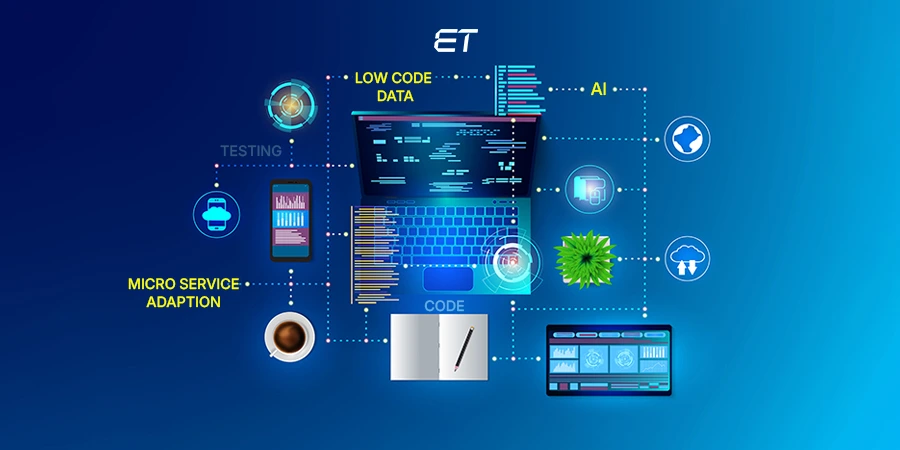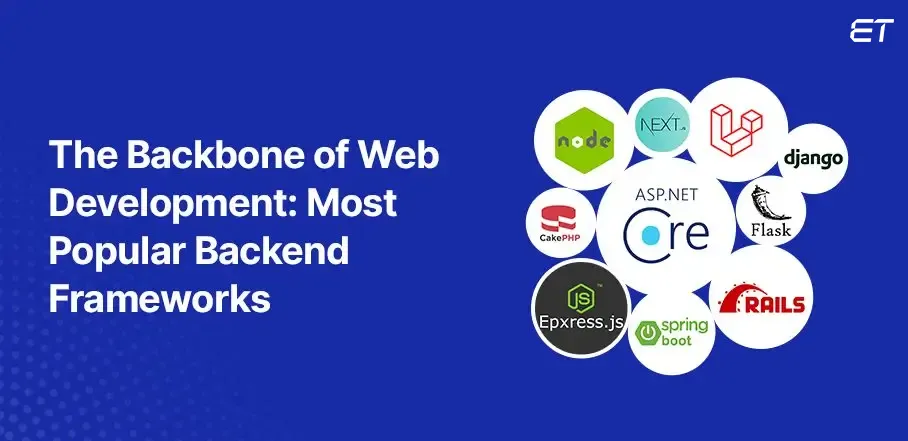
10 Most Popular Backend Frameworks for Web Development in 2025
- Web application development involves two main parts: frontend (user interface) and backend (engine)
- Backend frameworks are tools that aid in building the functionalities of a web application
- Using backend frameworks offers advantages such as pre-built templates, enforced coding standards, security features, and easier handling of complex applications
- The blog also contains content on why separate frameworks exist for frontend and backend development
There are two primary areas of operation in web application development: the frontend and the backend. The frontend ensures an attractive user experience, while the backend powers the application’s functionality. Together, they work to build a functional web application.
We have already covered top frontend technologies in our previous blog. This time, we will explore the most popular backend frameworks in 2025.
A website’s frontend, or user interface, is frequently considered its main focus. Still, the backend is where much of the magic happens. The backend has been referred to as the engine of a website, as it is where programmers define how a website will operate.
Like a frontend framework, every backend framework is based on a certain programming language. Using frameworks supported by several developers worldwide is a useful method for developing dynamic websites. According to recent studies, the backend framework market continues to grow, with Node.js being used by 47.12% of developers worldwide and Django holding 67,941 repository starts on GitHub.
Have a look at the significant benefits of using frameworks for web development:
- Frameworks provide pre-built templates and tools, saving development time
- They enforce coding standards, ensuring a uniform codebase.
- Frameworks often include security features to protect against common vulnerabilities.
- Frameworks offer a structured approach to handling growing applications.
- Frameworks often include testing tools for quality assurance.
Many of you may wonder why the frontend and backend can’t be developed using the same framework.
Using the same framework for both frontend and backend can limit flexibility and hinder specialization. Specialized frameworks enhance efficiency and offer better solutions for their respective roles, improving overall application performance.
The most popular backend frameworks can provide sophisticated client-focused methodology, data processing and database integration, and API route design and communication. They maintain synchronization throughout the software environment.
Determining the most effective framework is challenging, given the abundance of options. Before delving into the most popular backend frameworks in 2025, let’s take a closer look at them and their benefits in web development.
What are Backend Frameworks?
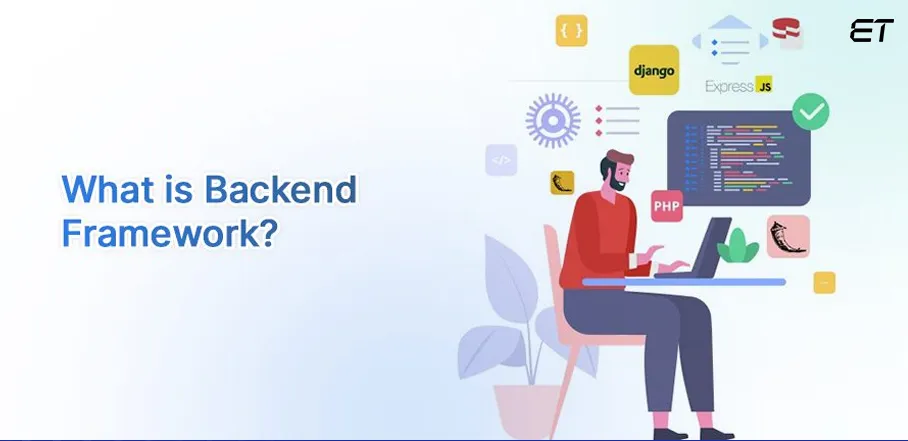
An ecosystem that facilitates the automation and acceleration of the web development process is known as a backend framework. It provides an organized framework for handling server requests, applying application logic, and maintaining databases.
Read the difference between frontend vs backend development.
Backend frameworks provide pre-built components, libraries, and tools that developers can leverage to create robust, efficient, and secure web applications. These frameworks are essential for managing the server-side operations that power web applications, ensuring their functionality and reliability.
Programming languages such as Ruby and JavaScript or compiled languages like Java, C#, etc., are the focus of these frameworks. Full stack developers can develop highly customized digital solutions using the most popular and top backend frameworks.
Looking for dedicated back-end developers who can boost your SDLC? Connect with us and understand the niche offerings.
Why is the Backend Framework Important?
Using the most popular backend languages and right frameworks in custom web development offers a plethora of benefits that enhances the efficiency and effectiveness of the development process. Here are some key advantages:
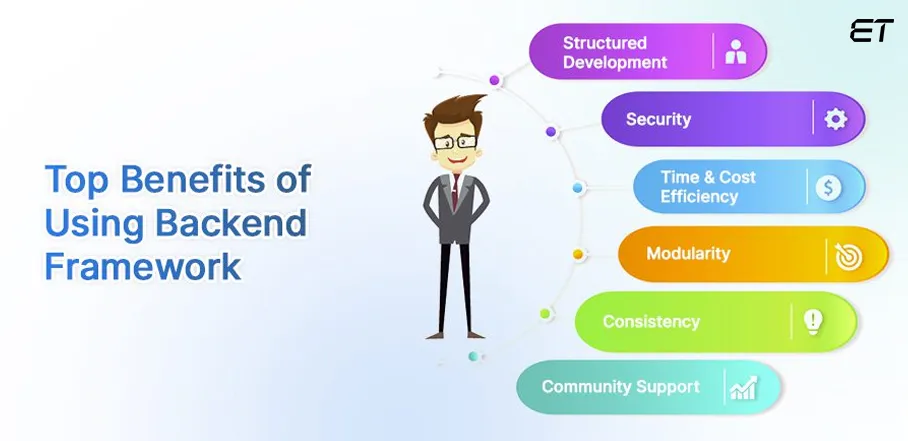
-
Structured Development
Most popular backend frameworks (like a NET framework) provide a well-defined architecture for building web applications. They offer a structured foundation for managing databases, handling server requests, and executing application logic. This structured approach simplifies development, reduces development time, and enhances code organization.
-
Security
Many backend frameworks are equipped with built-in security features. These technologies protect apps from widespread security flaws like cross-site scripting and SQL injection. Additionally, it can aid in developing a high-quality program that is immune to outside issues and subpar performance.
-
Time & Cost Efficiency
Best backend frameworks come with pre-built components, libraries, and tools. These components can include authentication systems, database connectors, and more. Leveraging these pre-existing top ten backend frameworks accelerates development, reducing project costs and time-to-market.
-
Modularity
The most used backend frameworks, which promote code consistency, also enable dedicated developers to decompose intricate application code into smaller, more manageable units (just like microfrontends), hence simplifying the task of app developers in terms of updating or adding new functionalities. This benefit leads to rapid development of mobile and web apps.
-
Consistency
The best thing about the most popular backend frameworks is that they give developers a uniform way to organize code, allowing them to maintain consistency in their code. Developer collaboration is facilitated by this consistency, which makes it simpler to comprehend and collaborate on each other’s code.
-
Community Support
Many backend frameworks have large and active communities of developers. These communities provide an invaluable resource for troubleshooting, offering guidance, and sharing best practices on features like user authentication and other functions. This community support promotes knowledge sharing and innovation.
-
Integration
Backend frameworks frequently make it easier to integrate third-party APIs and services. This integration capability expands the functionality of web applications by allowing them to interact with external services, tools, and data sources.
10 Best Backend Frameworks for Web Development
1. ASP.NET Core
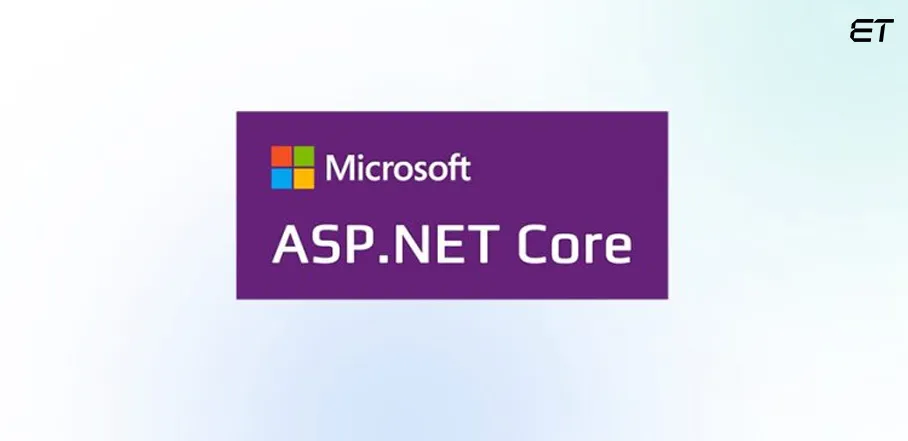
ASP.NET Core is a versatile and robust framework for building web applications. However, it can be used for both the frontend and the backend of web applications. But it is one of the most popular backend languages as it provides the tools and libraries necessary for developing the backend (server-side) of web applications.
When comparing ASP.NET with PHP, ASP.NET is advantageous for backend development due to its robust features, seamless integration with Microsoft technologies, strong security, scalability, and performance.
Learn how to optimize performance in .NET applications
It provides a comprehensive ecosystem for web and application development, making it suitable for enterprise-level projects and Windows-based environments, with excellent support for complex applications.
Top Features of ASP.NET Core
-
Cross Platform Functionality
A .NET development company won’t have to limit itself to a single platform thanks to ASP.NET Core’s cross-platform capability. With cross-platform compatibility, ASP.NET developers can create applications that work seamlessly across various operating systems and are compatible with all platforms.
-
Razor Pages
Razor Pages is a lightweight framework for building dynamic web pages. It simplifies the development of page-focused applications by combining the view and controller in a single Razor file.
-
Increased Security
A multitude of security features are available in the most recent version .NET 7. .NET Core has everything you need, including mechanisms for authorization and authentication, data security, and threat prevention.
-
Unification of Development Models
Using the same base class controller, the MVC and Web API development models are integrated. It enables web service and HTML (View) functionality to be exposed by a controller. Moreover, testable web apps and web APIs can be created using the features offered by ASP.NET Core’s MVC architecture.
ASP.NET Core Pros & Cons
| Pros | Cons |
| High performance and scalability | Potential breaking changes in updates |
| Built-in dependency injection | Migration challenges from ASP.NET Framework |
| Enhanced security features | Requires expertise in C# or F# |
| Razor Pages and MVC for web development | Limited legacy system compatibility |
| Open-source and community support | Smaller third-party library ecosystem |
2. Node.JS
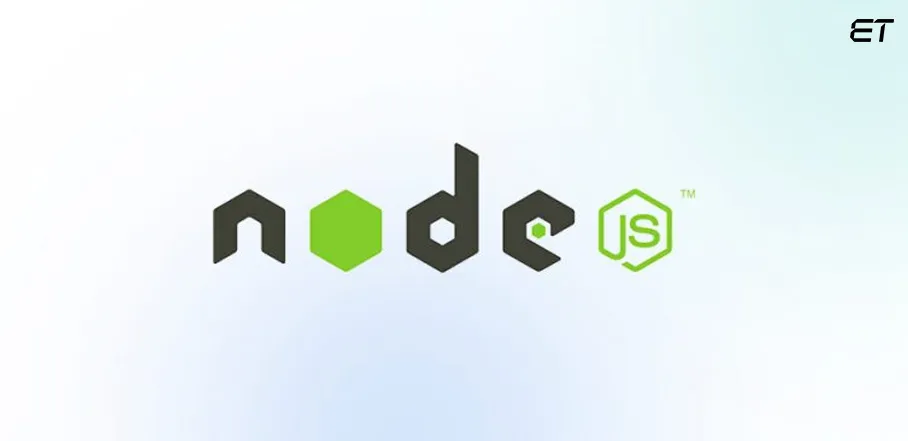
Node.JS is a cross-platform, open-source JavaScript runtime environment and library. It is used to run web applications outside of the client’s browser. Because Node.js is an asynchronous, event-driven framework, Node.js developers can use it to create server-side web apps that are ideal for processing large amounts of data.
The “Single Threaded Event Loop” architecture in Node.js allows it to manage several clients at once. Multiple clients submit requests in a multi-threaded request-response model, and the server handles each request before responding. Nevertheless, concurrent calls are processed by a number of threads. Every time a request is received, one of these threads designated in a thread pool is allocated to handle it. It is included in the list of most popular backend frameworks due to its amazing features.
Top Features of Node.js
-
Highly Scalable
Because Node.js apps run asynchronously (without blocking), they are incredibly scalable. Concurrent requests can also be handled effectively by Node.js. Its cluster module controls the load balancing of each active CPU core.
-
Event Driven
The “Event” module offered by Node includes a “EventEmitter” class that enables the use of event-driven programming. A function that is invoked when an event is triggered is called an event handler. After listening to the triggers, the main loop invokes the appropriate event handler.
-
Quick Code Execution
Node.js uses the V8 JavaScript Runtime motor and is also utilized by Google Chrome. The JavaScript motor has a wrapper provided by Hub, which speeds up the runtime motor. Consequently, this also speeds up Node.js’s request preparation process.
-
Node Package Manger
Node Package Manager or NPM is a package manager for the Node JavaScript runtime environment. It is the most extensive online repository in the world. It also handles the administration of our project’s local dependencies. About 50,000 to 80,000 packages are available for public access via its web repository.
Node.JS Pros & Cons
| Pros | Cons |
| High performance with V8 engine | Lack of strong multi-threading support |
| Ideal for real-time applications | Callback-based asynchronous code |
| Scalable with microservices | Less suitable for CPU-intensive tasks |
| Large open-source community | Limited enterprise-level libraries |
| Non-blocking, event-driven I/O | Single-threaded, CPU-bound tasks |
You can now connect with dedicated Node.js developers to build a unique project based on this wonderful back-end framework.
3. Ruby on Rail

One of the most used backend frameworks is Ruby on Rails (RoR), also known as Rails. It is a full-stack framework written in the Ruby programming language. Model-view-controller (MVC) is the foundation of this framework, which comes with an extensive toolset that covers both frontend and backend functionalities.
Web applications and application programming interfaces (APIs) can be developed with Rails; the latter can be used to create API-only apps, in which case the Rails application serves as the backend only. Additionally, we can design apps in which Rails handles both the frontend and back end. Hence, this framework is mostly used by full stack developers.
Top Features of Ruby on Rail
-
Library of Text Files
It offers functions for reading, writing, and manipulating text files, simplifying file operations. Developers can easily work with text files for tasks like configuration, logging, and data import/export using built-in Ruby libraries and Rails’ file handling capabilities.
-
Database Support
With dynamic database support, Ruby on Rails developers can select from various databases, such as MySQL, PostgreSQL, and SQLite. Because of this versatility, expert Ruby on Rails developers can choose the database that best fits their requirements and quickly switch between them as needed.
-
Automated Deployment
Libraries are included in Ruby on Rails, so code may be pushed to production faster and with less effort. It deploys all of your changes to the production with a single command interface line after a one-time initial setup.
-
Scaffolding
The programmer can specify the functionality of the application database with this feature. The framework then uses that information to generate the necessary code automatically. Interfaces are generated automatically via the scaffolding technique.
Ruby on Rail Pros & Cons
| Pros | Cons |
| Rapid development with convention over configuration | Potential security vulnerabilities |
| Built-in tools for common web development tasks | Fewer third-party libraries compared to other languages. |
| Excellent for MVP and startups | Performance limitations for CPU-bound tasks |
| Strong community and extensive documentation | Limited scalability for large applications |
| Developer-friendly, elegant code | Less suitable for complex, custom solutions |
4. Laravel
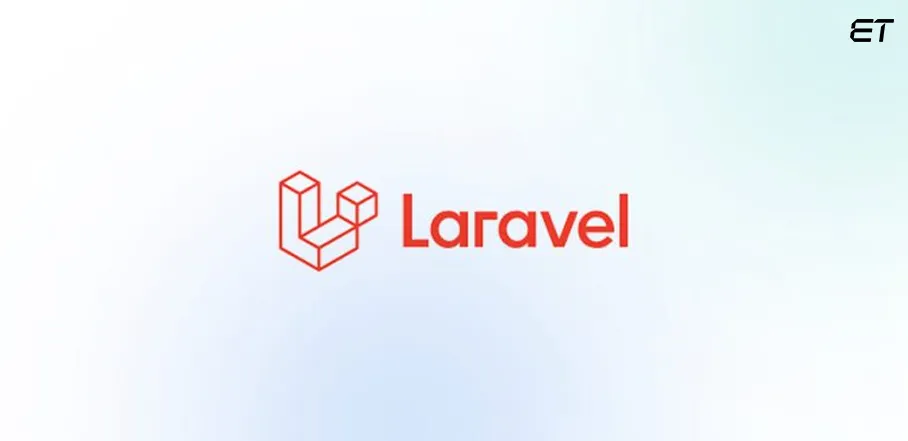
Laravel is a popular open-source PHP web application framework designed for developing web applications, especially those following the Model-View-Controller (MVC) architectural pattern. Laravel is one of the most popular backend frameworks due to its elegant syntax, developer-friendly approach, and large and active community.
Robust database features offered by Laravel include the ORM (Object Relational Mapping), Eloquent, and integrated seeders and migrations for databases. Application development can be accelerated by bootstrapping new models, controllers, and other components using Artisan’s command-line tool.
The latest version Laravel 10 is full of exciting features and functionality.
Top Features of Laravel
-
Routing
Because of Laravel’s expressive and adaptable routing architecture, Laravel developers can effectively manage HTTP requests and construct web routes. Route naming and parameter binding are supported.
-
Effective ORM
Laravel comes with an Object Relational Mapper (ORM) that is eloquent. You may perform object-oriented database operations and build associations between models easily with its help.
-
Unique Unit Testing
Laravel offers a special kind of unit testing. To determine whether changes harm the web application, the Laravel framework can perform many test cases. Developers can also write their own code for the test cases in Laravel.
-
Artisan Console
Laravel includes an Artisan command-line tool that automates various development tasks, such as creating controllers, migrations, and running unit tests. Developers can also create custom Artisan commands.
Laravel Pros & Cons
| Pros | Cons |
| Powerful, built-in features | Dependency on Composer for packages |
| Robust authentication and authorization | Performance overhead for some tasks |
| Active development and community | Limited scalability for large projects |
| Middleware for flexible routing | Complex configuration and setup |
| Elegant, expressive syntax | Some issues with shared hosting |
Stop researching the best Laravel experts. Evaluate our team’s offerings and boost your back-end development considerably.
5. Express.js
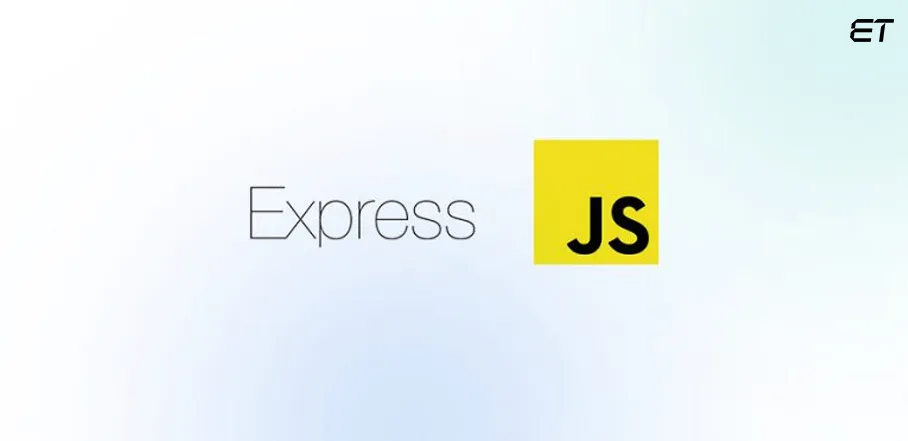
Express.js is one of the most popular backend frameworks and an excellent choice for backend development. It’s a lightweight and flexible Node.js framework well-suited for building APIs, web applications, and microservices.
Because Express is an opinion-free framework, dedicated developers can organize their code however they see fit rather than being forced to use a predetermined format.
Moreover, with a robust ecosystem of middleware and a simple, minimalist design, Express allows for quick and efficient development. Its non-blocking, event-driven architecture helps build scalable, high-performance applications, making it a preferred choice for many developers.
Top Features of Express.js
-
Quicker Server Side Development
Many frequently used functionalities found in Node.JS are included in Express.JS as functions. These functions can be easily used anywhere in the application for particular responsibilities.
-
Debugging
ExpressJS offers more user-friendly debugging tools with sophisticated features that allow you to identify the malfunctioning part of a web page precisely.
-
Session Management
While Express.js itself does not include a session management system, it is compatible with middleware like Express-session for implementing user sessions.
-
Middleware Ecosystem
Express.js has a vast ecosystem of middleware modules available through the Node Package Manager (NPM). These modules extend the framework’s functionality for various purposes, from authentication to compression.
Express.JS Pros & Cons
| Pros | Cons |
| Extensive documentation and resources | Steeper learning curve for beginners |
| High performance and scalability | Less built-in functionality compared to other frameworks |
| Minimal and unopinionated framework | Inconsistent API changes with major updates |
| Large and active community | Requires integration with additional packages for certain features |
| Easy to learn and use | Lack of structure and convention |
6. Django
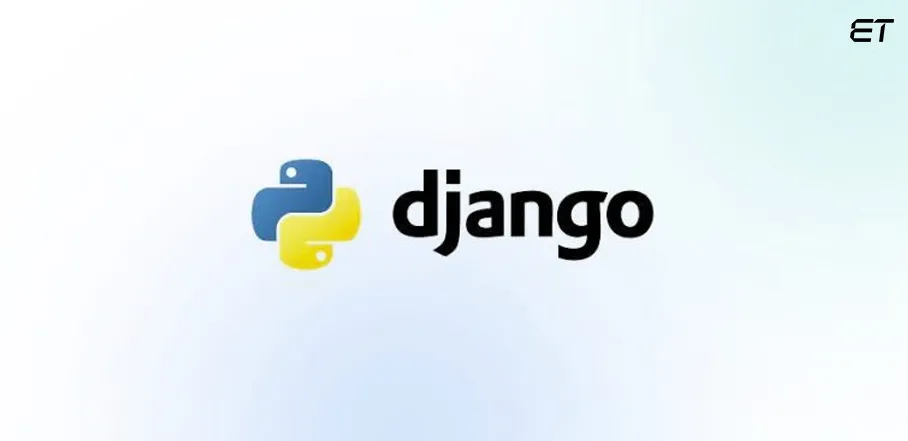
A high-level Python web framework, Django makes it possible to create secure and enduring websites quickly. It offers excellent documentation, a vibrant and active community, free and open-source software, and a wide range of free and commercial support alternatives.
Designing a web application using the Django web framework rather than from scratch is more efficient, which necessitates developing the backend, APIs, JavaScript, and sitemaps. Web developers might have more flexibility when working with the Django web framework and concentrate on designing a distinctive application than using a web development tool. That’s why it is considered one of the most popular backend frameworks.
Django is one of the first choices for developing web portals.
Top Features of Django
-
SEO Friendly
The Python framework is SEO-friendly since most of its source code is readable by humans. In addition to offering several libraries to enhance the webpage’s meta description, which search engines use to determine the website’s ranking, Django also enables you to create optimized URLs for search engines.
-
Batteries Included
Django follows the “batteries-included” philosophy, offering a comprehensive set of components, such as an ORM, admin interface, authentication system, and more, to accelerate development.
-
High Security
The Django ecosystem includes a wide range of packages and libraries, both official and community-contributed, expanding the framework’s functionality.
-
Versatile in Nature
Django is a flexible framework that may be used to develop apps across numerous industries. These days, businesses use Django to develop a wide range of applications, including scientific computing platforms, social networking sites, and content management systems.
Django Pros & Cons
| Pros | Cons |
| Extensive documentation and community support | A bit rigid, may limit flexibility |
| Secure and battle-tested with robust security | Complex for small or simple projects |
| High-level Python framework with built-in ORM | Initial setup can be time-consuming |
| Versatile, including RESTful API development | Not as suitable for real-time applications |
| Scalable and well-suited for large projects | Can lead to slow websites |
7. Spring Boot
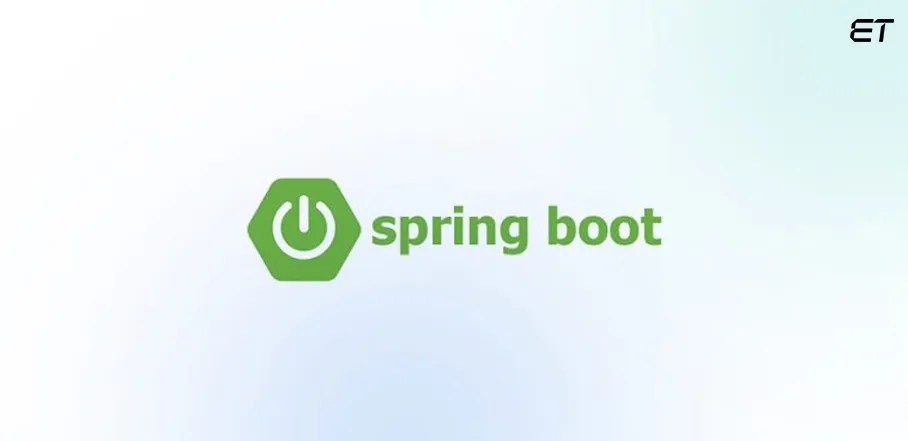
Thanks to Spring Boot, an open-source technology, Java microservices and web programs can be more easily created with Java-based frameworks. Java is among the most well-liked and extensively used programming languages and computer systems for building apps. Therefore, any discussion about Spring Boot must begin with Java. Java is the first language that dedicated developers learn to code all around the world.
The built-in features of the Spring Framework support an application’s common needs, including data binding, type conversion, validation, handling exceptions, resource and event management, internationalization, and more.
Top Features of Spring Boot
-
Auto Configuration
Spring Boot simplifies the setup and configuration of your application. It automatically configures common components, reducing the need for manual configuration.
-
Admin Support
Enabling admin-related functionalities for an application is made possible by Spring Boot. It is employed for remote application management and access. The spring.application.admin.enabled property is all we need to do to enable it.
-
Embedded Web Services
Spring Boot supports various embedded web servers, enabling the easy creation of web applications. Developers can choose from Tomcat, Jetty, and Undertow, among others.
-
Extensibility
Developers can extend Spring Boot by adding custom functionality and creating custom starters to simplify using common libraries and tools.
Spring Boot Pros & Cons
| Pros | Cons |
| Rapid development with pre-configured templates | Heavy memory usage in some cases |
| Excellent community and extensive documentation | Complex configuration for specific use cases |
| Integrated security and easy testing | Potential over-engineering for simple projects |
| Enterprise-ready and well-maintained | Steeper learning curve for beginners |
| Microservices support with Spring Cloud | Potential dependency version conflicts |
8. Flask

Developers may quickly and easily create lightweight web apps using the Flask framework. POCCO, the International Group of Python Enthusiasts, led by Armin Ronacher, developed this framework. The WSGI toolkit and Jinja2 templating engine serve as its fundamental foundations.
Flask is one of the most popular backend frameworks due to its simplicity and flexibility. It empowers developers to create web applications with minimal boilerplate code, making it ideal for quick development and prototyping. Flask’s micro-framework approach allows easy customization and integration with other libraries, contributing to its popularity and versatility.
Top Features of Flask
-
Micro Framework
Flask is a minimal framework, providing only the essentials for web development. This simplicity allows web developers to add components and libraries as needed, avoiding bloat.
-
Routing
Flask offers a straightforward routing system, making it easy to define URL patterns and associated view functions for handling HTTP requests.
-
HTTP Request and Response Handling
It simplifies handling HTTP requests and responses, allowing easy access to request data and the ability to return various types of responses, including JSON and HTML.
-
RESTful Routing
Flask allows developers to create RESTful routing patterns easily, facilitating the development of RESTful APIs and services.
Flask Pros & Cons
| Pros | Cons |
| Flexible and customizable architecture | Dependency on external libraries |
| Extensive documentation and active community | Not suitable for large, complex apps |
| Well-suited for small to medium-sized projects | Lacks some enterprise-level features |
| Ideal for quick prototyping and development | Requires manual configuration |
| Simple and easy-to-learn for beginners | Limited built-in features |
9. Cakephp
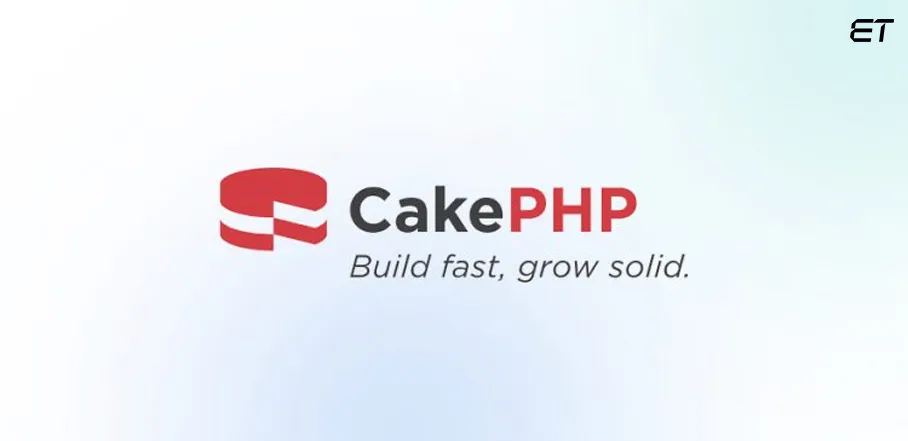
CakePHP is a quick and most popular backend framework for PHP that is free and open source. It provides programmers with the fundamental framework needed to build web applications. Its main objective is to provide the tools you need to work quickly and efficiently without sacrificing flexibility.
CakePHP includes features such as scaffolding, which generates basic CRUD functionality, and an integrated ORM for database interaction. It offers built-in tools for security, authentication, and data validation. Its conventions over configuration (CoC) and sensible defaults reduce the need for extensive configuration. CakePHP is known for its ease of use, developer-friendly design, and ability to create feature-rich web applications with minimal coding rapidly.
Top Features of Cake PHP
-
User Friendly Tool
Its excellent user-friendliness is one of the reasons it has become so widely used and adopted. It makes complicated websites easier for you to navigate. Furthermore, modifying the website using CakePHP to meet company needs is simple.
-
Integrated Authentication
CakePHP includes an authentication system for user management, making it easy to add user-based functionality.
-
Ability to Innovate
One of the reasons why it is the most popular backend framework is that it gives significant knowledge, multiple talented resources, support for unit testing, and the essential abilities to ensure that it offers the best functionality
-
CRUD Scaffolding
CakePHP provides a powerful scaffolding feature for quickly generating basic Create, Read, Update, and Delete (CRUD) functionality for database tables.
CakePHP Pros & Cons
| Pros | Cons |
| Built-in security features and authentication | Convention over configuration may limit flexibility |
| Active and helpful community | Slower performance compared to some alternatives |
| Rapid application development with code generation | Learning curve for newcomers |
| Well-suited for small to medium-sized projects | Smaller ecosystem and fewer third-party plugins |
| Extensive documentation and tutorials | Frequent updates may lead to compatibility issues |
10. Next.js
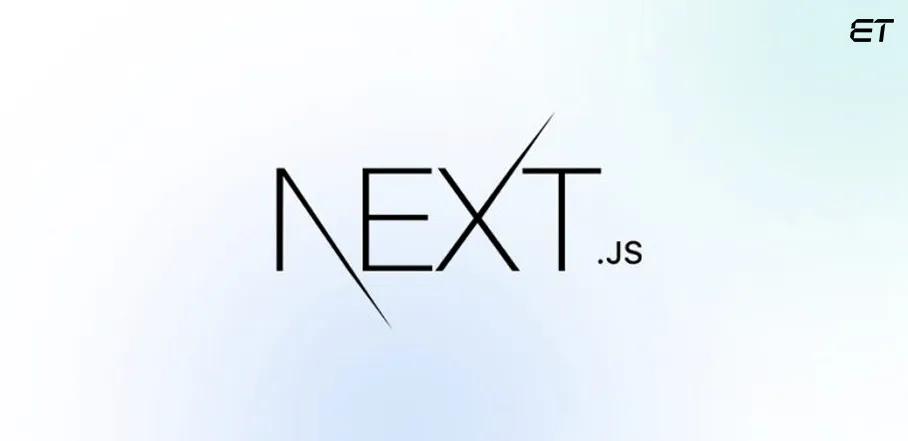
With the help of the JavaScript framework Next.js, you can create React-powered web apps and static web pages that load incredibly quickly and easily.
It provides a set of features and conventions that streamline web development, making it easier to create server-rendered React applications. This framework simplifies the process of building modern, high-performance web applications while ensuring good SEO (Search Engine Optimization) performance and a smooth user experience.
Top Features of Next.js
-
Built in CSS
CSS records can be imported from a JavaScript file using Next.js. This makes sense because Next.js expands the concept of importing outside of JavaScript.
-
TypeScript
It has robust support for TypeScript, offering type safety and improved code quality for projects using TypeScript.
-
Pre-Rendering
It supports server-side rendering (SSR) as well as static generation (SSG). A one-page React application employs client-side rendering (CSR), whereas server-side rendering (SSR) prepares the content of a page on a server.
-
File System Based Routing
Routing is based on the project’s file system structure, making it intuitive and straightforward to define routes. Creating new pages is as simple as adding a new file.
Next.JS Pros & Cons
| Pros | Cons |
| Server-side rendering for fast initial page load | Complex setup for some advanced features |
| SEO-friendly and improved search engine visibility | Potential for larger bundle sizes |
| Automatic code splitting for optimized performance | Requires Node.js on the server |
| Strong community support and rich ecosystem | Less suitable for simple static sites |
| Simplifies routing and navigation | Lack of built in state manager |
How to Choose the Best Backend Frameworks for your Dream Project?
Although we have covered the top ten backend frameworks 2025 in the blog, you have to choose one for your project.
Here are some pointers to help you choose the best one to provide the needed functionality to your application.
- Select a framework that can seamlessly handle increased traffic and data demands.
- Assess your team’s skill set. Opt for a framework that aligns with their proficiency to expedite development and reduce the learning curve.
- Evaluate the framework’s speed and efficiency. Look for benchmarks and real-world performance results.
- Prioritize security features. Ensure the framework supports robust authentication, data encryption, and protection against common vulnerabilities.
- Check if the framework integrates well with your chosen technology stack, including databases, front-end libraries, and third-party services.
By carefully considering these factors, you can choose the best backend framework to align with your dream project’s goals and set it up for success.
Do you want to start your next web app project with an experienced and proficient development team? You don’t need to scroll any longer because eLuminous Technologies is a great tech partner for hiring back-end developers. Our enormous talent pool of developers using the most popular backend frameworks has served various industries to create high-quality projects that result in a faster growth rate in this cutthroat market. Let’s connect for more details!
Frequently Asked Questions
1. What is the difference between the backend and the frontend?
The frontend focuses on the presentation and user experience, while the backend deals with data processing, storage, and business logic.
Read our detailed comparison guide- Frontend vs Backend
2. What are the free-of-cost most popular backend frameworks?
Some popular free (open-source) backend frameworks are Express.js (Node.js), Django (Python), and Ruby on Rails (Ruby). These frameworks are widely used for web development and offer various features for building server-side components of applications without incurring licensing costs.
3. How do you choose the best backend development company?
To choose the best backend development company, consider their experience, expertise in relevant technologies, portfolio, client reviews, and ability to understand your project’s requirements. Ensure they align with your project’s goals and offer cost-effective solutions.
4. What is the most demanded backend framework?
Node.js is the most demanded backend framework due to its high performance, scalability, and widespread use in building real-time applications.
5. Is NodeJS a backend framework?
Node.js is not a backend framework; it is a runtime environment that allows you to execute JavaScript on the server side. While it is commonly used for backend development, frameworks like Express.js are built on top of Node.js to streamline the development process.
6. How to build a low-code app?
To build a low-code app, start by selecting a suitable low-code platform. Use the platform’s visual interface to drag and drop components, configure business logic with minimal coding, and integrate necessary APIs. Finally, test and deploy your app.
7. Is there a free low-code no-code app builder?
Yes, there are free low-code/no-code app builders available, such as AppGyver, Glide, and Adalo, which offer basic features at no cost.
8. Is low-code no-code the future of app development?
Low-code/no-code platforms are rapidly gaining popularity due to their ability to speed up development, reduce costs, and make app creation accessible to non-developers, indicating a significant shift towards this approach in the future.
9. What is the best platform for low-code android app development?
OutSystems, Mendix, and Appian are considered some of the best platforms for low-code Android app development due to their robust features and ease of use.
10. What is the best platform for low-code IOS app development?
For iOS app development, platforms like OutSystems, Mendix, and Quick Base are highly recommended for their comprehensive toolsets and user-friendly interfaces.


